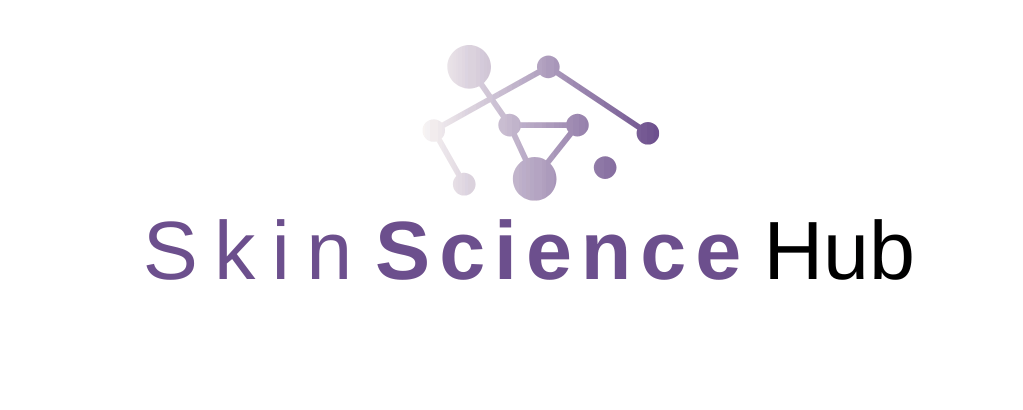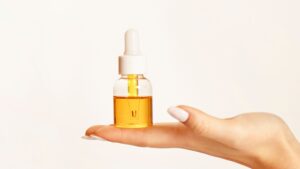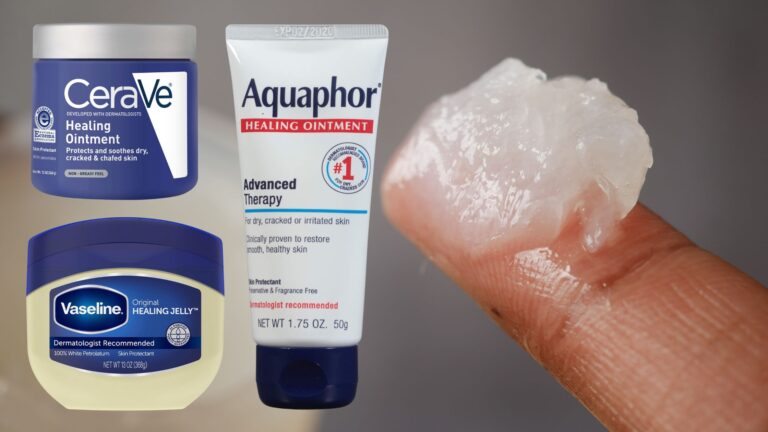Which Exfoliating Serum Is Right for Your Skin?
Your exfoliating serum choice matters more than you think. Dull skin that won’t brighten, texture that foundation can’t hide, or stubborn clogged pores, these all need different types of chemical exfoliants to actually improve.
You start researching and hit the terminology wall: glycolic, lactic, mandelic, salicylic acid, percentages, pH levels, molecule sizes. Every article assumes you already know which acid does what.
Here’s the truth: different acids work on different problems because they work in fundamentally different ways. This guide shows you which acid matches your concern, which strength to start with, and which products deliver results in 2-12 weeks.
Not sure you’re ready for serums yet? Read our guide to upgrading from toners first. For broader skincare concerns, check out our complete guide to building a skincare routine.
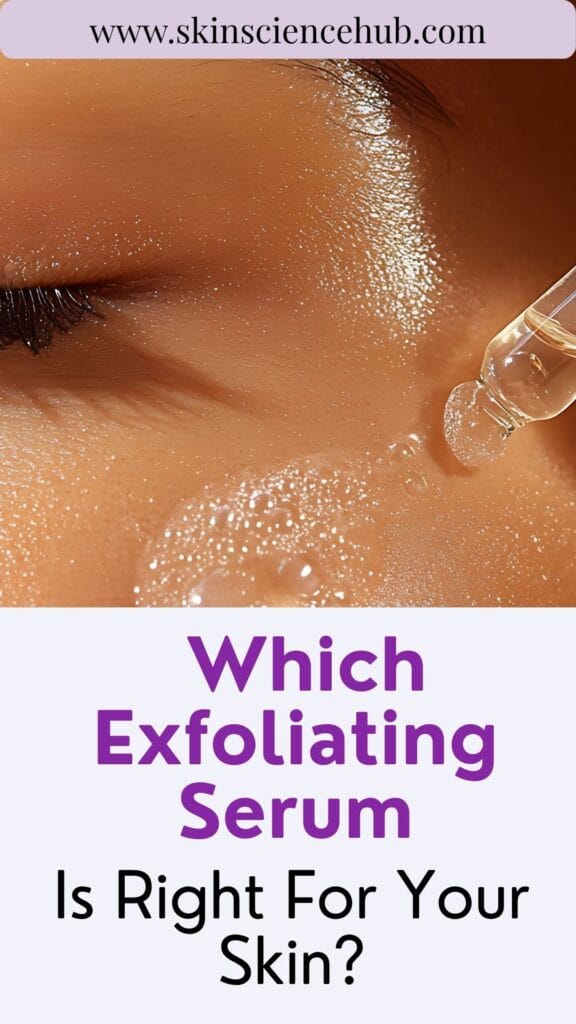
Glycolic vs Lactic vs Mandelic Acid: What’s the Difference?
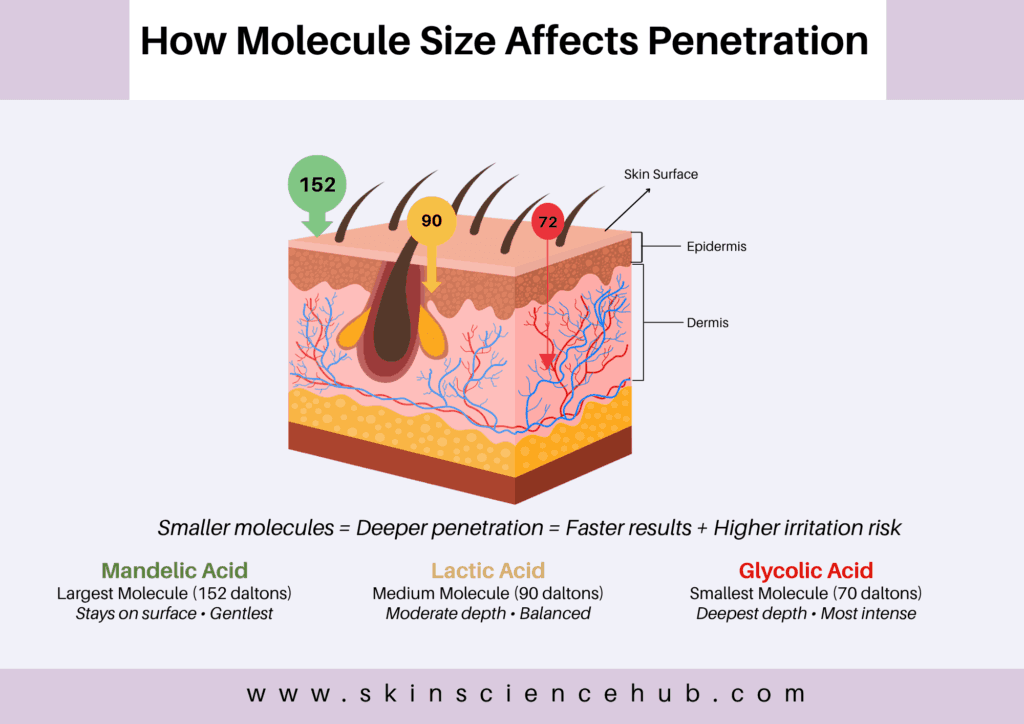
All three AHAs (alpha hydroxy acids) exfoliate your skin’s surface, but they sit on a spectrum: fast and intense on one end, slow and gentle on the other. Dermatologists explain that the tradeoff is simple, smaller molecules penetrate deeper for faster results but higher irritation risk. Larger molecules work more slowly on the surface but rarely cause problems.
Glycolic acid has the smallest molecule, so it penetrates deepest. This means visible results in 1-2 weeks, but it’s the most likely to cause redness or irritation. Choose this if you have resilient normal-to-oily skin and want maximum speed.
Lactic acid sits in the middle with moderate penetration. You’ll see results in 2-3 weeks with much better tolerance than glycolic. It’s also naturally hydrating, which makes it ideal for dry skin. This is the best starting point for most people.
Mandelic acid has the largest molecule, so it works primarily on the surface. Results take 3-4 weeks, but it rarely causes irritation even on very sensitive or rosacea-prone skin. It also has antibacterial properties that help with acne.
Here’s how they stack up side-by-side:
| Acid | Speed to Results | Irritation Risk | Best For |
|---|---|---|---|
| Glycolic | 1-2 weeks | Highest | Normal/oily, want fast results |
| Lactic | 2-3 weeks | Medium | Dry/dehydrated, first serum |
| Mandelic | 3-4 weeks | Lowest | Very sensitive, rosacea |
If you’re unsure which to choose, start with lactic acid at 5%, it works for the widest range of skin types and you can always switch later. Use this table to compare if you’re torn between two acids.
Glycolic Acid Serums: Best for Fast Results & Anti-Aging
Let’s break down each acid starting with the fastest.
Choose glycolic if you want the fastest visible improvements, you’ll feel smoother texture within days and see visible brightness by week 2-3. By week 8-12, fine lines soften and dark spots fade noticeably. This works best for normal to oily skin that doesn’t get easily irritated. Multiple clinical studies have demonstrated glycolic acid’s effectiveness for anti-aging because it penetrates deep enough to boost collagen production and accelerate cell turnover.
The tradeoff: higher irritation risk. Skip glycolic if you have very sensitive skin, active rosacea, or eczema.
Best for: Stubborn dullness, rough texture, early aging signs, old acne scars
What Strength Should You Start With?
Start at 5% for 4-6 weeks to build tolerance. Move to 7% if you had zero irritation – this is the sweet spot where most people maintain long-term. Only try 10% after using 7% successfully for 2-3 months. That’s maximum home-use strength.
How to Use Glycolic Acid
Apply at night after cleansing on dry skin. Start with 2x weekly (Monday/Thursday), spacing applications 48+ hours apart. Wait 5-10 minutes before applying moisturizer. After a month with no irritation, you can increase to 3x weekly. Daily SPF 50+ is mandatory.
Best Glycolic Acid Serums
The Ordinary Glycolic Acid 7% Toning Solution – This absorbs in seconds without any sticky feeling. I recommend starting here because it’s strong enough to work but won’t overwhelm your skin like 10% formulas can. Start 2x weekly, build to 3x weekly after a month.
Paula’s Choice 8% AHA Gel Exfoliant – If you hate liquid textures or have oily skin, this gel absorbs quickly without residue. It’s a good step up after you’ve used 7% successfully for 2-3 months and want slightly more intensity.
Lactic Acid Serums: Best for Dry Skin & Beginners
If glycolic sounds too intense, here’s the gentler option most people love.
Choose lactic if you want strong exfoliation without glycolic’s irritation risk. Results appear within 2-4 weeks, and by week 10-12 you’ll see significantly refined texture, faded dark spots, and that healthy glow. The key benefit: lactic is naturally hydrating. According to cosmetic chemists, lactic acid helps your skin retain moisture while it exfoliates, most acids are drying, but lactic is the exception, making it ideal for dry skin.
This is the best starting point for most people. After 2-3 months, you can upgrade to glycolic for faster results, or switch to mandelic if you experienced any sensitivity. Start at 5% for 6-8 weeks, then move to 10% once your skin tolerates it well. This 10% concentration is where most people maintain long-term.
Best for: Dry/dehydrated skin, first serum experience, anyone who found glycolic irritating
Need help with other dry skin concerns? Check our complete dry skin guide.
How to Use Lactic Acid
Apply at night after cleansing on dry skin. Start with 2x weekly (Monday/Thursday), spacing applications 48+ hours apart. Wait 5-10 minutes before applying moisturizer. After 6-8 weeks with no irritation, you can increase to 3x weekly. Daily SPF 50+ is mandatory.
Best Lactic Acid Serums
The Ordinary Lactic Acid 5% + HA – This is the gentlest serum-strength you can get, and the added hyaluronic acid means your skin stays hydrated while it exfoliates. Start here if you’re new to serums or nervous about irritation. Use 2x weekly for 6-8 weeks.
The Ordinary Lactic Acid 10% + HA – Same hydrating formula, double the strength. Once you’ve used 5% successfully, move to this for faster results while maintaining that gentle, hydrating feel.
Mandelic Acid Serums: Best for Sensitive & Acne-Prone Skin
For truly sensitive skin, there’s an even gentler choice.
Skincare experts recommend mandelic for very sensitive or reactive skin that gets irritated easily, or if you have rosacea. Results take longer, you’ll notice gradual improvements by week 3-6, with significant refinement by week 12-16 but the slow, steady progress means your skin tolerates it well without irritation setbacks. It’s also the safest choice for deeper skin tones concerned about post-inflammatory hyperpigmentation from irritation.
Here’s the thing: even 10% mandelic is gentler than 5% glycolic because of the molecule size difference. So most people can start at 10% without issue. If you’re extremely sensitive, start at 5% and you can stay there permanently.
Bonus: mandelic has antibacterial properties that glycolic and lactic lack, making it good for sensitive skin with mild acne.
Best for: Very sensitive/reactive skin, rosacea-prone skin, deeper skin tones, sensitive skin with acne
How to Use Mandelic Acid
Apply at night after cleansing on dry skin. Start with 2x weekly (Monday/Thursday), spacing applications 48+ hours apart. Wait 5-10 minutes before applying moisturizer. Because mandelic is so gentle, you can increase to 3-4x weekly after a month if your skin tolerates it well. Daily SPF 50+ is mandatory.
Best Mandelic Acid Serums
The Ordinary Mandelic Acid 10% + HA – Lightweight formula with hyaluronic acid. Even at 10%, this rarely causes irritation, which is why I recommend it for sensitive skin. Use 2x weekly initially, and you can increase to 3-4x weekly if your skin tolerates it well.
Stratia Soft Touch AHA – Gel formula with 10% mandelic plus a small amount of lactic acid. This gives you slightly faster results than pure mandelic while maintaining the gentleness. Good progression if you’ve used pure mandelic successfully and want a bit more intensity.
BHA Serums (Salicylic Acid): Best for Oily Skin & Blackheads
But what if your main issue isn’t texture, it’s clogged pores?
Choose BHA (beta hydroxy acid) instead of AHAs if your main concerns are clogged pores, blackheads, or acne. You’ll see pores getting clearer by week 2-6 (after an initial purging phase), and by week 8-12 you’ll have significantly clearer pores, fewer breakouts, and less oil production. Cosmetic chemists explain that BHA (salicylic acid) is oil-soluble, which allows it to penetrate into your pores to dissolve sebum and debris from inside. Alpha hydroxy acids only work on the surface.
The good news: BHA also has anti-inflammatory and antibacterial properties, plus it doesn’t significantly increase sun sensitivity the way AHAs do.
Best for: Clogged pores, blackheads in T-zone, whiteheads, oily skin, mild to moderate acne
Why BHA Stays at 2%
Here’s why this matters: unlike AHAs, BHA doesn’t need higher concentrations. The oil-soluble penetration makes even 2% highly effective. Products claiming 5%+ are professional peels, not daily serums.
How to Use BHA
Apply after cleansing on dry skin, you can use it morning or night, your choice. Start with 2x weekly (Monday/Thursday), spacing applications 48+ hours apart. Wait 5-10 minutes before applying moisturizer. After 4 weeks with no irritation, you can increase to 3x weekly. Expect potential purging in weeks 1-2 as it clears congestion from your pores.
Best BHA Serums
Paula’s Choice Skin Perfecting 2% BHA Liquid Exfoliant – This is the gold standard BHA that most people consider the best salicylic acid product available. The lightweight liquid absorbs quickly without feeling greasy, and the green tea extract helps calm any inflammation. Start 2x weekly, build to 3x weekly after 4 weeks.
The Ordinary Salicylic Acid 2% Solution – Budget-friendly option with a simple, no-frills formulation. The texture is slightly thicker than Paula’s Choice, which some people prefer because it feels more like a traditional serum. Same usage: start 2x weekly, build to 3x weekly.
Now that you know which acid to choose, here’s what you need to know about using them safely, especially if you picked an AHA.
How to Use Exfoliating Serums Safely (SPF Required for AHAs)
Chemical exfoliants increase sun sensitivity and require careful use to avoid irritation. Follow these safety guidelines regardless of which acid you choose.
Sun Protection: The Non-Negotiable Rule
AHAs (glycolic, lactic, mandelic) increase sun sensitivity for 7 days after each application. Research shows this increased photosensitivity makes your skin more vulnerable to sun damage, which is why you must use SPF 50+ every single morning, even on days you don’t apply serum and reapply every 2 hours when outdoors. Skip your AHA 5-7 days before beach vacations or extended sun exposure. If you can’t commit to daily SPF 50+, use BHA instead.
BHA doesn’t significantly increase sun sensitivity the way AHAs do, but you still need daily broad-spectrum sunscreen because sun protection is non-negotiable for anyone serious about skin health. The benefit of BHA is that you don’t need to be quite as vigilant about reapplication or worry about dramatic photosensitivity, but the baseline need for SPF 50+ remains.
Don’t Mix These With Exfoliating Serums
Never use exfoliating serums in the same routine as:
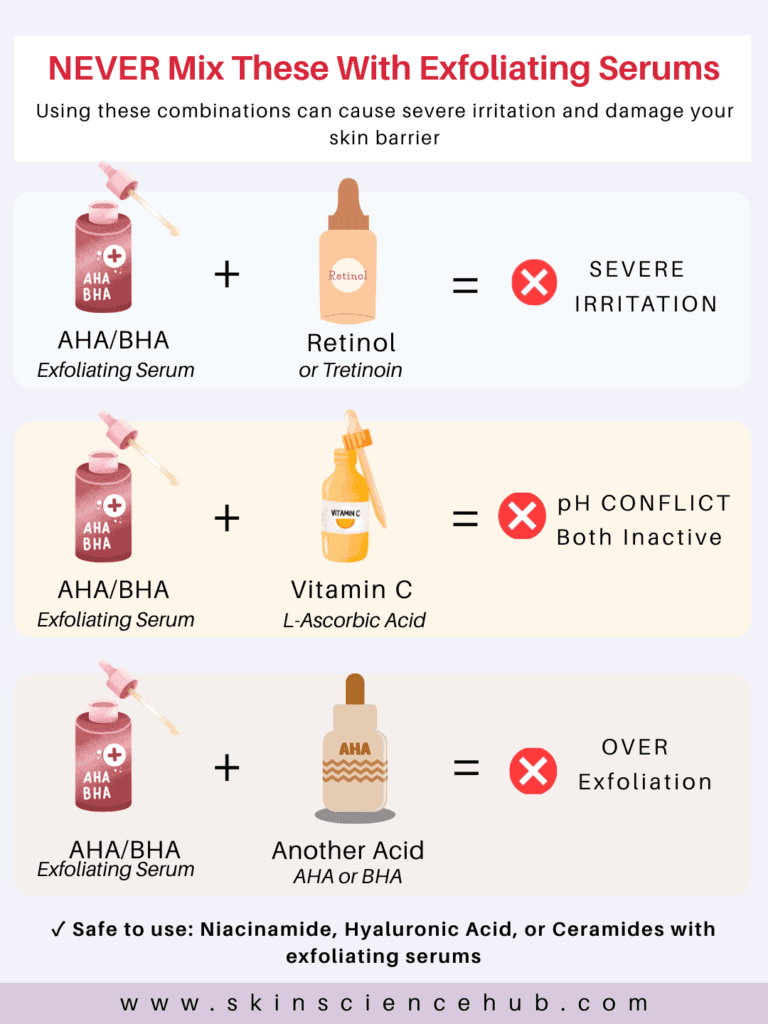
- Retinol or prescription retinoids – Alternate nights entirely to avoid severe irritation
- Vitamin C (L-ascorbic acid) – Use vitamin C in the morning, acids at night to prevent pH conflicts
- Other exfoliants – No AHA + BHA on the same day, no serums + physical scrubs together
Other Important Rules
Stop using serums 3-5 days before waxing, laser hair removal, or professional peels. Resume 5-7 days after. Never use on active eczema, open wounds, sunburned skin, or during rosacea flares. If you’re pregnant or breastfeeding, consult your OB-GYN before using any exfoliating serums.
Dermatologists recommend using serums 2-3x weekly maximum, spacing applications 48+ hours apart to allow your skin time to recover. Give any acid 12 full weeks before judging whether it works for you.
The Bottom Line
Start with lactic acid at 5% if you’re unsure, it works for the widest range of skin types and balances effectiveness with safety. After 2-3 months, you can upgrade to glycolic for faster results or switch to mandelic if you experienced sensitivity.
Choose BHA instead if your main concern is clogged pores, blackheads, or acne rather than texture and dullness.
The key is picking one chemical exfoliating serum and sticking with it for at least 12 weeks. Consistency matters more than choosing the “perfect” acid.
